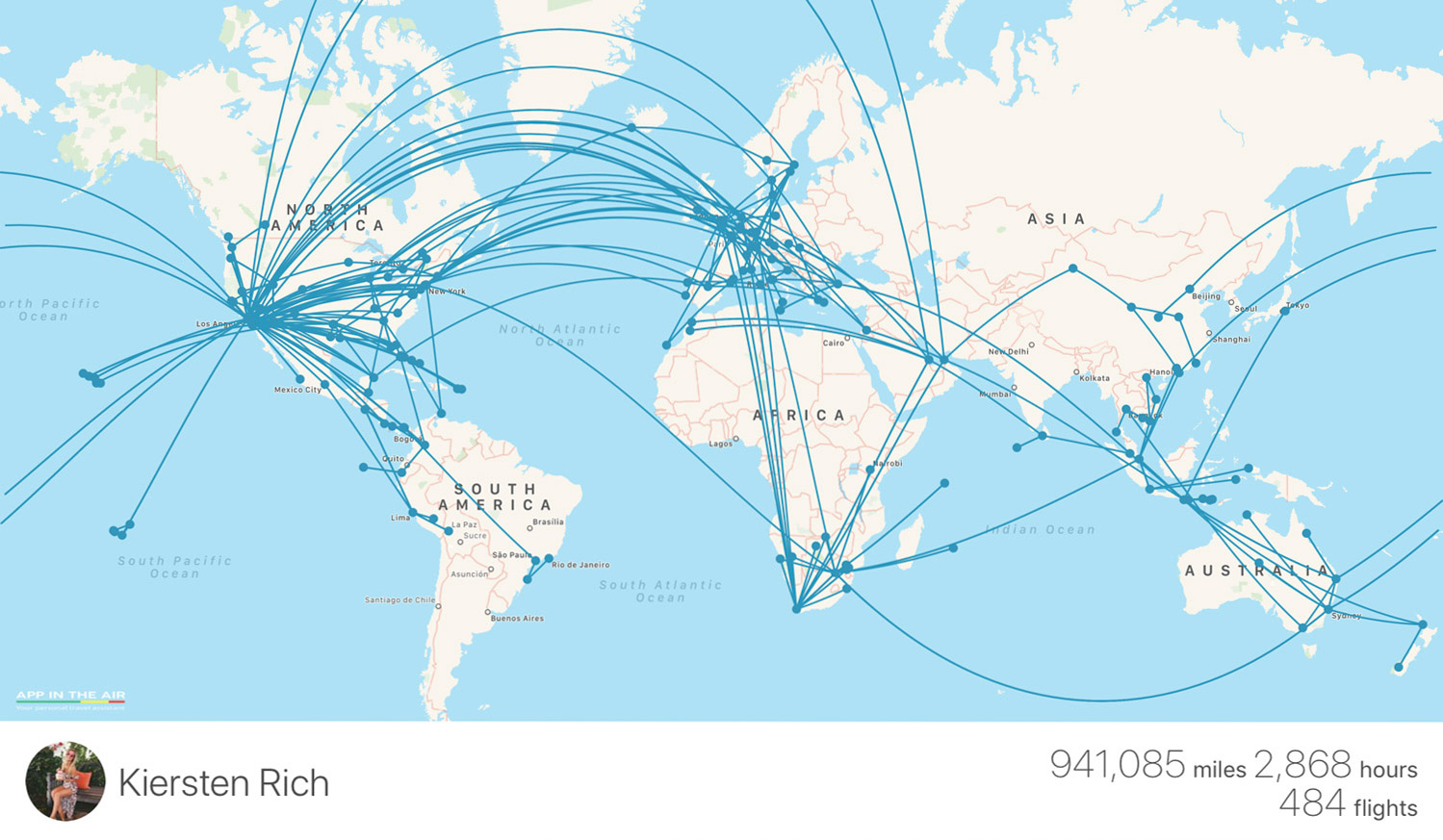Since boarding my first international flight in 2008 to study abroad in Spain, I’ve used air travel extensively to get around. While I’m extremely fortunate to be able to afford airline tickets and enjoy the benefits of business class travel, I know that air travel is not the best thing for our environment.
I’ve flown nearly 1,000,000 miles and, while it’s an impressive number, there are some seriously unimpressive things about air travel.
Short or long-haul flights use a HUGE amount of C02. With climate change starting to have a real-world effect on our environment and scientists giving us until 2030 to curb global warming or face an increase in droughts, floods, extreme heat, and food shortages, we all need to look at how we can reduce our impact.
While I’ve already pledged to take fewer flights this year, I’m not stopping there. With flights being my biggest contributor to carbon emissions, I’ve decided to set a goal in 2019 to offset my carbon footprint from flying.
Here’s how I’m reducing my carbon footprint, and how you can too!
What is a Carbon Footprint?
A carbon footprint is defined as the total amount of greenhouse gases produced to, directly and indirectly, support human activities, usually expressed in equivalent tons of carbon dioxide. In other words, when you drive a car, the engine burns fuel which creates a certain amount of CO2.
The same goes for when you heat your house with oil, gas, coal, or electricity. Even the production of your food contributes to CO2 emissions.
What is a Carbon Offset?
“A Carbon offset is a way to compensate for your emissions by funding an equivalent carbon dioxide saving elsewhere. Our everyday actions, at home and work, consume energy and produce carbon emissions such as driving, flying and heating buildings.” – Carbonfootprint.com
It’s important to note that we need to reduce our carbon emissions before we focus on offsetting them. This is because when we donate to a carbon offset project, we are paying someone else to cut their emissions, so we don’t have to.
The best way to reduce your carbon footprint is to fly less often, drive fewer miles and avoid overheating or cooling your home. Read more about how to Reduce Your Environmental Impact While Traveling.
Do Planes Make That Much of a Difference?
Overall, the aviation industry accounts for 11% of all the transportation-related emissions in the US. Some estimates say that about 20,000 planes are in use in the world, serving three billion passengers annually.
By 2040, there could be more than 50,000 in service, and they’ll be flying more often.
How Can You Reduce Your Carbon Footprint?
Reduce Your Transportation Emissions
If you live in a city with decent public transportation, consider using that as an option to commute to work. Alternatively, try to start a carpool with your colleagues that live nearby to reduce the number of cars on the road and your CO2 emissions.
While there are not many ways around a transatlantic flight, trains and public transportation (like public buses) are more economical when exploring a city! If you’re traveling in Europe, for example, you might be tempted to book the 1-hour flight over the 6-hour train journey. Consider your impact on the environment!
Train travel is my absolute favorite way of getting around — you slow down and get to see so much more!
For flights, you need to start calculating how much CO2 you’re emitting with each trip. Here are a few of my favorite sites that have free CO2 emissions calculators that you can use:
Choose “Green” Airlines
Another thing to keep in mind when you fly is the number of times you take off. With 25% of airplane emissions coming from landing and taking off, you’ll reduce your carbon footprint by choosing a leg that flies nonstop.
It’s also a good idea to research the different airlines and what they are doing to reduce their impact on the environment. The ICCT posts aviation reports annually!
The Most Fuel-Efficient Domestic US Airlines:
- Alaska
- Frontier
- Spirit
- Southwest
- Hawaiian
Not only do fuel-efficient airlines help reduce the impact of emissions, but the savings in fuel is also usually passed down to the consumer. That’s why airlines like Norwegian and Spirit tend to be less expensive!
Donate to Carbon Offsetting Projects
There are also a lot of organizations that you can donate to that make it their mission to offset the world’s carbon footprint. My personal favorites are The Nature Conservancy and Natural Resources Defense Council (NRDC).
Here’s an awesome list of reputable environmental charities!
Even if you can’t afford to donate to an organization, you can shop with AmazonSmile. Each time you shop through the site, Amazon donates 0.5% of the price of your eligible purchases to an organization of your choice.
Read More: How to Reduce Your Environmental Impact While Traveling
What Am I Doing?
It’s obviously a privilege to be able to travel as much as I do, let alone to afford to donate to carbon offsetting projects. As someone who is fortunate enough to travel frequently, I feel that it’s my responsibility to lessen my impact on the world that I love so much.
Flights: Aside from flying less, for my personal travels, I will personally be donating to organizations like The Nature Conservatory to offset my flight footprint. For business travel, I am requiring that any brand, hotel or tourism board that wants to host me for a campaign, donate to carbon offsetting projects. My goal is to be a carbon-neutral flyer in 2019, and every year moving forward!
At Home: We’ve been working hard to make our apartment in Cape Town as “green” as possible! While not everything directly offsets our footprint, I still like to celebrate small efforts! We have a small compost bin in our kitchen to help separate biodegradable items from recycling and trash. And, since the Cape Town water crisis, we’ve also gotten used to taking fewer and shorter showers. We also don’t have air conditioning or heating since we live on the beach, which helps reduce our energy consumption!
To hold myself accountable, I’ll be sharing all of my flights and carbon offsetting donations here.
2019:
| Flight Route | C02 (in Tons) | Carbon Offset Donation |
|---|---|---|
| Nassau to San Diego (via Miami) | 1.6 | $46 |
| Los Angeles to Cape Town (via Doha) | 7.8 | $224 |
| Cape Town to Sydney (via Joburg) | 4.5 | $128 (donated by CNET) |
| Sydney to Cape Town (via Joburg) | 4.5 | $128 (donated by CNET) |
| Cape Town to Nelspruit (via Joburg) | .39 | $11 |
| Nelspruit to Cape Town (via Joburg) | .39 | $11 |
| Cape Town to Cairo (via Dubai) | 3.9 | $101 |
| Dubai to Los Angeles (Round Trip) | 10.3 | $283 |
| Dubai to Cape Town (Round Trip) | 5.5 | $151 |
| Dubai to London | 2 | $54 |
| London to Ireland (Round Trip) | 0.33 | $10 |
| London to Boston (Round Trip) | 3.7 | $103 |
| London to Mykonos | 0.5 | $14 |
| Santorini to Venice | 0.28 | $8 |
| Venice to Cape Town (via Istanbul) | 3.0 | $81 |
| Cape Town to Amman (via Dubai) | 3.0 | $82 |
| Amman to San Diego (via Chicago) | 4.1 | $112 |
| Los Angeles to Guayaquil (via Panama, Quito) | 3.92 | $107 |
| Guayaquil to San Cristobal | 0.23 | $6 |
| Galapagos to Panama City (via Quito) | 0.47 | $13 |
| Panama City to Los Angeles | 0.8 | $22 |
| San Diego to New York City | 0.66 | $18 |
| New York City to Cape Town (via Joburg) | 2.44 | $66 |
| TOTAL | 64.31 | $1,779 |
2020:
| Flight Route | C02 (in Tons) | Carbon Offset Donation |
|---|---|---|
| Cape Town to Nairobi (via LVI, EBB) – RT | 1.961 | $61 |
| Cape Town to Windhoek – RT | .502 | $16 |
| Cape Town to Dubai – RT | 4.8 | $148 |
| Cape Town to New York | 4.1 | $128 |
| New York to San Diego | 1.2 | $39 |
| San Diego to Seattle – RT | .592 | $19 |
| Los Angeles to Papeete – RT | 2.1 | $67 |
| San Diego to Utah (via Denver) – RT | .797 | $25 |
| San Diego to Seattle – RT | .625 | $19 |
| TOTAL | 16.68 | $522 |
Donations
| Organization | Donation |
|---|---|
| Donated by CNET | $256 |
| Earth Alliance Amazon Fund | $1,097 |
| Institute for Sustainable Communities | $426 |
| 350.org | $522 |
| TOTAL | $2,301 |

Overall
We can all take small steps to help reduce our carbon footprint and slow down climate change as much a possible. If we all work together to make donations and make a conscious effort to reduce our C02 emissions, we can create positive change and ensure that the world as we know it will be around for future generations to explore.
Will you also take the pledge to become a carbon-neutral flyer? Let me know in the comments below!



















I loved reading this. It’s incredibly refreshing to hear there is another person who takes keeping our environment healthy seriously.
I’ve been donating to various organizations but was happy to learn about the ones you mentioned here. I also will be using the calculators and will donate to them as you are doing! Very inspirational. *^_^*
I started making these changes as well in 2019 and I am so much happier now that I have. It’s not perfect and I know there’s always room for improvement but that’s why I love posts like these from people I trust — like you — there’s always more to learn. For instance, I love asking clients to support these efforts as well and I changed my Amazon Smile setting to support Climate Action Reserve as well. I was donating to another organization but frankly I don’t think it was as important as climate change is. We all need to take that more seriously! Thanks for sharing this, Kiki! <3